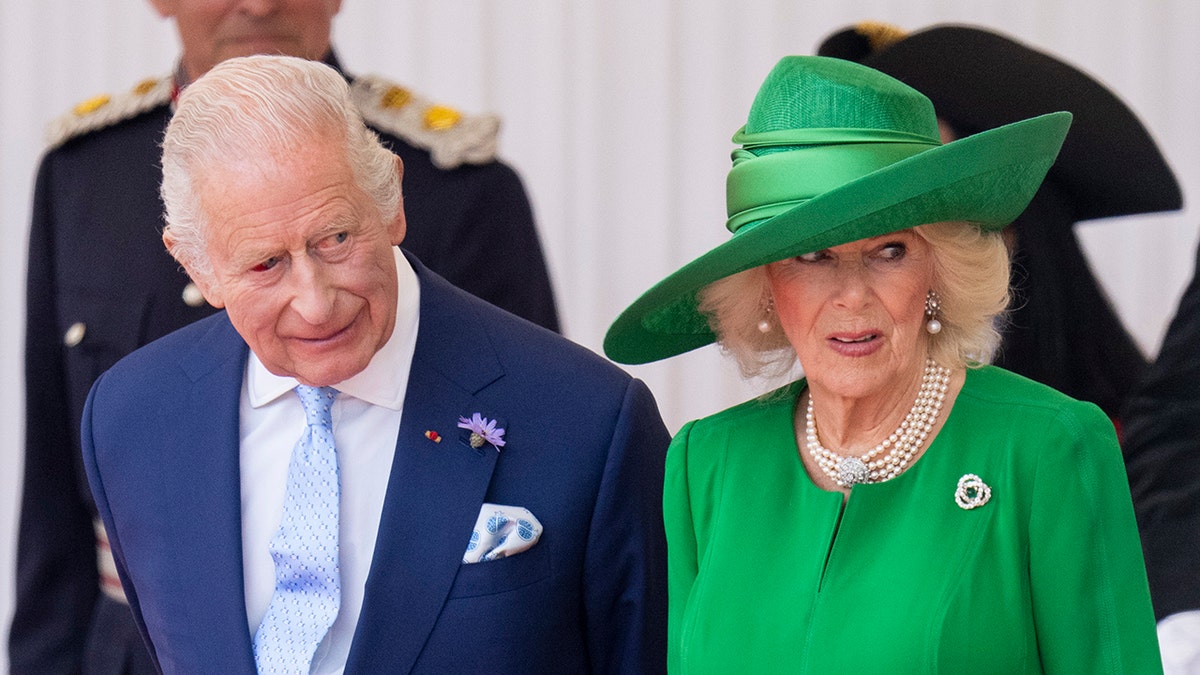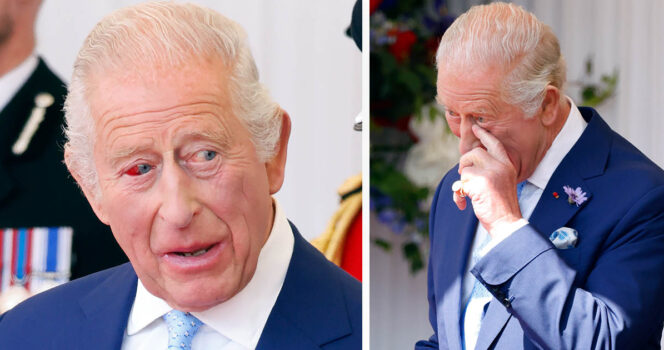King Charles III continues to perform royal duties despite ongoing cancer treatment, demonstrating commitment to public service and the monarchy. The 75-year-old monarch was diagnosed with cancer in early 2024, following treatment for an enlarged prostate. Since then, Buckingham Palace has issued updates confirming he would adjust his workload but remain actively involved in key engagements where possible.
On Wednesday, July 10, 2025, King Charles hosted French President Emmanuel Macron and First Lady Brigitte Macron at Windsor Castle during a formal state visit. The occasion included ceremonial welcomes, official meetings, and a diplomatic luncheon attended by members of both countries’ delegations. Photos from the event captured the King smiling and engaging with guests alongside Queen Camilla.
Public Appearance Raises Questions About His Health — What We Know
During the visit, some images showed King Charles with a bloodshot right eye, prompting social media discussions about his health. While such a symptom might appear concerning at first glance, medical experts widely agree that this condition — known as a subconjunctival hemorrhage — is typically harmless and often results from minor causes.
According to the Mayo Clinic, a broken blood vessel in the eye can be caused by a strong sneeze, cough, eye rubbing, or minor trauma. Although it may look alarming, the discoloration usually fades within 1 to 2 weeks without requiring treatment.
There has been no indication from Buckingham Palace or official sources that this condition is related to his cancer treatment. As with any health-related matters concerning public figures, speculation should be avoided unless confirmed by reliable or medical sources.
The Monarch’s Transparent Approach to Health
In a historic shift for the British monarchy, King Charles became the first reigning sovereign to publicly disclose a cancer diagnosis, breaking with the traditionally private approach to royal health matters. The announcement in February 2024 included a statement from Buckingham Palace explaining that the King’s condition was discovered during treatment for a separate issue and that he would begin outpatient care immediately.
Speaking at a May 2024 event focused on cancer support services in the UK, King Charles made a personal reference to his experience, expressing admiration for patients, caregivers, and healthcare professionals. He emphasized the importance of compassion, community, and resilience during treatment — sentiments that resonated with many across the country.

Royal Family Adapts to Health Challenges with Modern Transparency
Royal experts and historians have noted that King Charles’ openness marks a modernizing shift in how the monarchy communicates with the public. In the past, the health of royals — including King George VI — was kept private, even from the individuals themselves. In contrast, the current monarch’s transparency helps reduce stigma and raises awareness of issues faced by millions of citizens.
This openness aligns with King Charles’ long-held vision for a streamlined and modern monarchy. He has often spoken about adapting royal traditions to suit a contemporary United Kingdom, a vision supported by the next generation of royals, including Prince William and Princess Catherine.

Reports on Cancer Status: What’s Official?
While various outlets have discussed King Charles’ health in broad terms, Buckingham Palace has not issued any statements indicating that his cancer is incurable or that he is in end-of-life care. Reports to the contrary have stemmed from unnamed sources and should be treated as unverified unless supported by official updates.
The Palace’s last formal communication noted that the King’s treatment is progressing and that he is responding positively. He has resumed a “modest programme” of public duties and continues to receive medical guidance. As with any patient undergoing treatment, periods of rest and reduced engagement are expected and do not necessarily signal negative developments.

King Charles’s Schedule: Balancing Duty and Recovery
In line with medical advice, King Charles has been gradually returning to public life. His team has confirmed that he plans to take a short summer break to rest, likely at Balmoral Castle in Scotland, a traditional summer retreat for the Royal Family. However, even while resting, the King remains engaged with state matters, including reading government briefings and approving documents.
According to a Telegraph report, a Palace aide said the monarch is managing his condition “incredibly well.” The source emphasized that King Charles continues to approach life and duty with focus and resolve, and that advances in cancer treatment have enabled many individuals to maintain active roles in their professional and personal lives.

Public Reactions and Support
The King’s willingness to remain visible and active in royal life has earned widespread support from the public and public figures alike. Many view his continued presence at high-profile events — such as the D-Day 80th anniversary in Normandy and the Trooping the Colour parade — as an encouraging sign of strength.
Despite inevitable scrutiny, King Charles has not indicated any intention to abdicate, and there are no formal provisions in place that suggest a transition of the throne is imminent. British monarchs historically serve until death unless exceptional circumstances arise, such as severe cognitive impairment or a personal choice to abdicate — both of which are not present in this case.

Conclusion
King Charles’ recent appearance with President Macron highlights his enduring commitment to royal duties, even while managing a personal health challenge. Though a bloodshot eye captured attention online, medical experts confirm this is a common and usually minor condition.
As he continues his recovery, the King’s blend of transparency, resilience, and service serves as a modern example of royal leadership. Future appearances will continue to be shaped by medical advice, but all official updates affirm that King Charles remains engaged, positive, and focused on his role as head of state.
Sources:
- Buckingham Palace Official Statements
- BBC News
- The Mayo Clinic – Subconjunctival Hemorrhage
- Sky News
- The Telegraph

